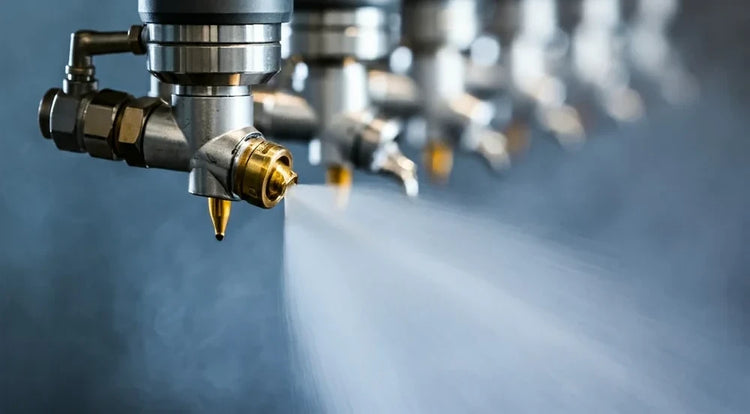Dry Fog Dust Suppression Systems for Mining & Aggregates
Ultra-fine misting with minimal water addition. NozzlePro dry fog dust suppression systems deliver particle sizes under 10 microns with only 0.1% weight water addition, capturing dust before it becomes airborne while maintaining product quality and eliminating reclaim area moisture issues.
What is Dry Fog Dust Suppression?
Dry fog dust suppression is a precision misting technology that creates ultra-fine water droplets—typically 7.5 to under 10 microns in size—that agglomerate airborne dust particles and cause them to fall to the ground before becoming inhaled. Unlike traditional wet dust suppression systems that add significant moisture to product, dry fog systems add less than 0.1% water by weight, preserving material quality while dramatically improving air quality.
This innovative approach is transforming dust control in mining operations, aggregate processing, cement production, and material transfer points where moisture must be minimized but dust control is non-negotiable.
🔬 Understanding Droplet Size & Dust Suppression Efficiency
Droplet Size = Suppression Effectiveness: Particles smaller than 10 microns remain airborne longest and represent the greatest health hazard. Dry fog systems create droplets at 7.5 microns or smaller, matching or exceeding the size of suspended dust particles. This size compatibility ensures rapid agglomeration and precipitation.
Water Addition = Material Impact: Traditional systems add 0.3-0.5% water by weight, affecting product quality, dust migration, and reclaim area conditions. Dry fog systems add only 0.1% water—a measurement so precise it's barely detectable in final product testing. This minimal moisture addition preserves material specifications while delivering superior dust control.
Dry Fog Technology Explained
Achieving ultra-fine droplets with minimal water addition requires sophisticated nozzle engineering and system design. NozzlePro dry fog systems employ air-atomizing technology where compressed air and water are combined at the nozzle to create an ultra-fine mist.
How Dry Fog Systems Work
- Air-Atomization Technology: Compressed air (4-8 bar) and water combine at precision nozzles to create ultra-fine mist without requiring high hydraulic pressures
- Micro-Droplet Generation: Air-shearing forces break water into droplets under 10 microns—optimal size for dust particle agglomeration
- Minimal Water Consumption: Precise control of water flow (typically 0.5-2 LPM per nozzle) means less than 0.1% moisture addition by weight
- Extended Atmospheric Residence: Fine droplets remain suspended longer, increasing dust contact time and suppression efficiency
- Rapid Agglomeration: When dust particles contact ultra-fine droplets, moisture causes them to cluster and fall—suppression happens before dust is inhaled
System Components
A complete dry fog dust suppression system includes:
- Compressed Air Supply: 4-8 bar compressor system with drying and filtration to ensure consistent, clean air
- Water Supply: Low-pressure source (typically gravity or 1-2 bar pump) delivering precise flow control
- Air-Atomizing Nozzles: Precision-engineered nozzles designed specifically for dust suppression droplet size and coverage
- Distribution Headers: Strategically positioned to cover transfer points, crusher zones, and conveyor discharge areas
- Control Systems: Manual or automated activation tied to equipment operation for on-demand suppression
Dry Fog vs. Traditional Dust Suppression: Technical Comparison
Understanding the differences between dry fog and traditional systems helps explain why dry fog is transforming industrial dust control:
| Characteristic | Dry Fog (Air-Atomizing) | Traditional Hydraulic |
|---|---|---|
| Droplet Size | <10 microns (7.5μ optimal) | 50-200+ microns |
| Water Addition | <0.1% by weight | 0.3-0.5% by weight |
| Operating Pressure | 4-8 bar (air + water) | 20-100+ bar (hydraulic) |
| Dust Capture Speed | Ultra-fine mist captures particles instantly | Larger droplets take longer to settle |
| Material Impact | Minimal moisture = no product degradation | Excess moisture affects stockpile conditions |
| Reclaim Area Drying | Minimal moisture = rapid natural drying | Wet zones require extended drying time |
| Energy Consumption | Lower pump pressure = reduced costs | High pressure requires large pump systems |
| Best For | Dry climate mining, moisture-sensitive material, transfer points | General dust suppression, wet mining operations |
The data is clear: dry fog systems deliver superior dust control efficiency while preserving material quality. For operations where moisture is problematic—like aggregate mining, coal handling, and cement production—dry fog is transforming how companies approach dust management.
Why Dry Fog Dust Suppression Transforms Operations
Superior Dust Capture – Ultra-fine droplets (7.5μ) match or exceed dust particle size for instant agglomeration and settlement
Minimal Moisture Addition – <0.1% water by weight preserves material specifications and eliminates product degradation
Reclaim Area Benefits – Rapid drying times with minimal standing water eliminates zone maintenance issues and equipment stalling
Lower Energy Costs – 4-8 bar system pressure vs 20-100+ bar hydraulic means significantly reduced pump and compressor loads
Faster Dust Suppression – Extended atmospheric residence time of fine mist increases dust-water contact opportunities
Worker Safety & Health – Superior air quality from better dust control improves respiratory health and OSHA compliance
Dry Fog Applications in Mining & Aggregates
Dry fog dust suppression excels in specific high-demand scenarios where traditional systems fall short:
💨 Crusher Transfer Points
Suppress dust at primary, secondary, and tertiary crusher discharge. Dry fog systems positioned at transfer points capture dust before it becomes airborne. Explore dust control solutions →
📦 Conveyor Belt Systems
Prevent dust release along conveyor belt transfer points and discharge. Dry fog's minimal moisture means no belt slippage or degradation of conveyed material. Ideal for coal, aggregates, and minerals.
🏗️ Aggregate Stacking & Reclaim
Suppress dust during aggregate stacking and reclaim operations. Minimal moisture addition maintains product specifications while eliminating fugitive dust. Reclaim areas remain dry and operational.
⛏️ Mining Face & Extraction
Deploy dry fog at mining faces for real-time dust suppression during extraction. Lower pressure systems are safer for underground operations and reduce equipment wear. Explore mining solutions →
🏭 Cement & Coal Processing
Critical for moisture-sensitive processes. Dry fog delivers superior dust control without product degradation. Preserves material characteristics in thermal processing applications.
🌱 Grain & Agricultural Handling
Ultra-low moisture addition protects grain quality. Dry fog prevents spoilage and maintains commodity grades while controlling dust hazards at grain elevators and transfer points.
NozzlePro Dry Fog System Types
Different operations demand different deployment approaches. NozzlePro offers optimized dry fog systems for every scenario:
Stationary Dry Fog Headers
Best for: Fixed transfer points and conveyor discharge areas requiring continuous dust control.
- Multiple nozzles on manifold header for broad coverage
- Permanent or temporary installation options
- Manual or automated activation with equipment interlocks
Mobile Dry Fog Systems
Best for: Temporary sites, rotating operations, or emergency dust suppression at multiple locations.
- Portable air compressor and water tank configuration
- Quick-disconnect nozzle arrays for rapid deployment
- Efficient for seasonal or project-based operations
Spray Lances for Precision Targeting
Best for: Tight spaces, hard-to-reach zones, and manual dust control operations.
- Hand-held or articulated lance designs
- Operator control of mist placement and intensity
- Ideal for maintenance areas and emergency cleanup
Crusher-Mounted Dry Fog
Best for: Direct integration on crushing equipment for source-point suppression.
- Nozzles positioned at crusher discharge
- Automated activation with crusher operation cycles
- Eliminates post-discharge dust release completely
Dry Fog System Technical Specifications
Understanding system parameters ensures optimal dust suppression performance:
| Parameter | Specification | Impact on Performance |
|---|---|---|
| Droplet Size | 7.5 – 10 microns (μ) | Matches dust particle size; instant agglomeration and settlement; sub-10μ optimal for respirable dust capture |
| Water Addition | <0.1% by weight | Negligible moisture impact on material; rapid natural drying; preserves product specifications |
| Air Pressure | 4 – 8 bar | Low pressure reduces pump energy costs; safer underground operations; achieves ultra-fine atomization |
| Water Flow | 0.5 – 2 LPM per nozzle | Precise control ensures <0.1% moisture addition; prevents over-saturation; maintains material quality |
| Coverage Area | 5 – 15 meters radius | Fine mist travels farther; covers transfer points and discharge areas; adjustable based on nozzle placement |
| Nozzle Spacing | 2 – 4 meters apart | Overlapping coverage ensures no dust bypass zones; optimizes suppression efficiency without excessive overlap |
| System Activation | Manual or automated | Automated with equipment reduces labor; manual for flexible deployment and emergency response |
How to Design a Dry Fog Dust Suppression System
Implementing an effective dry fog system involves careful planning and optimization:
- Map Dust Sources: Identify all primary dust generation points—crushers, conveyors, transfer chutes, stacking areas, reclaim zones.
- Assess Moisture Sensitivity: Determine how sensitive your product is to moisture. Dry fog excels when moisture is problematic; traditional systems work where moisture is acceptable.
- Calculate Air Supply Needs: Size compressor for 4-8 bar delivery; typically 5-10 CFM per nozzle depending on coverage requirements and droplet size target.
- Plan Water Source: Establish clean water supply (filtration recommended); low-pressure gravity feed or 1-2 bar pump sufficient for precise flow control.
- Position Nozzles Strategically: Place at source points (crusher discharge) for maximum efficiency; cover 2-4 meter wide zones with overlapping mist patterns.
- Configure Control System: Manual activation for flexibility or automated interlocks tied to equipment operation for consistent suppression.
- Specify Nozzle Type: Air-atomizing nozzles specifically designed for dust suppression; ensure droplet size specification of 7.5-10 microns.
Complementary Dust Control Solutions
Dry fog systems are most effective as part of a comprehensive dust management strategy:
Dust & Pollution Control Kits
Complete systems for site-wide dust suppression. View dust control options →
Air-Atomizing Nozzles
Precision nozzles for ultra-fine mist generation. Explore air-atomizing nozzles →
Fog & Mist Nozzles
High-performance fine mist for dust suppression. Browse fog nozzles →
Cooling & Quenching Nozzles
For thermal dust suppression and material cooling. View cooling solutions →
Full Cone Spray Nozzles
Traditional hydraulic suppression for wet operations. Explore full cone →
Tank Cleaning Nozzles
For reclaim area cleaning and maintenance. View tank cleaning →
Frequently Asked Questions About Dry Fog Dust Suppression
What makes 7.5 micron droplets ideal for dust suppression?
How does <0.1% water addition work for moisture-sensitive materials?
What's the difference between air-atomizing and hydraulic high-pressure systems?
How much compressed air does a dry fog system require?
Can dry fog work in humid or wet climates?
What maintenance do dry fog systems require?
Transform Your Dust Suppression Operations
NozzlePro dry fog dust suppression systems deliver ultra-fine misting with minimal moisture impact. Superior dust capture, preserved material quality, and reduced energy costs. Perfect for mining, aggregates, cement, and any operation where traditional suppression adds too much water. Contact our dust control specialists today.

